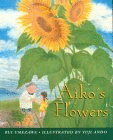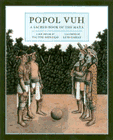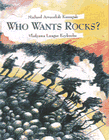Aiko’S Flowers

by Rui Umezawa
24 pages,
ISBN: 0887764657
Popol Vuh, Or The Sacred Book Of The Maya

by Victor Montejo
96 pages,
ISBN: 088899334X
Who Wants Rocks?

by Michael Arvaarluk
24 pages,
ISBN: 1550375881
Post Your Opinion | | Children’S Books
by Mariella BertelliCanadian children’s books are outstanding tools for crossing cultural boundaries and helping young readers explore the riches of our multicultural society. This fall, three new picture books explore the cultures of the Mayans, Canada’s North, and ancient Japan.
Publishing Latin American stories is integral to Groundwood’s mission, and with Popol Vuh they share with us an ancient text created by the Mayans. The written record miraculously survived, thanks to the initiative of a young Mayan K’iche’ man who, in 1558 in Guatemala, wrote it down in Latin characters. This work was later translated by a Spanish priest in 1701. Now it comes to us in a version carefully adapted by Mayan/Guatemalan anthropologist Victor Montejo for older children and those interested in myths and legends.
Popol Vuh, or the Sacred Book of the Maya, is a work of mythic proportions: it relates the foundations of the Mayan civilization through creation stories and traces the lineage of the Mayan lords until their destruction by the Spaniards. It contains elements common to other mythologies: the battle of the gods and demi-gods, forbidden fruit, twin brothers and animals as messengers, observers or participants. The mythical narrative does break in spots and acquires a folk tone, which makes the reading smoother and more familiar.
Luis Garay’s carefully balanced art work realistically interprets the stories. His images are tableaux and almost photographic in nature, catching the characters in actions suspended in time. Garay etches dramatic representations and landscape with such attention that they are extraordinarily lifelike: these could be Guatemalan people at work today, except for unusual details like the marked skins of the twins or the masked faces of the gods. The figures’ poses and costumes are stylized, emphasizing the ritualistic while creating a distancing effect. The gods may have moved among the people, but they are still gods—the distinction is apparent and recognizable to all.
This is a beautifully crafted book: its design matches the high tone of the stories. It would be interesting to see the material illustrated in a more abstract style, highlighting the fantastical and hyperbolic elements; but then the book would probably lose its distinctive Latin American quality that Luis Garay has so carefully recreated.
Who Wants Rocks? is an original story created by Innuit storyteller Michael Kusugak about the Gold Rush in the Yukon and how man’s actions can affect the environment. The story personifies the landscape—mountains can see and hear—and when Old Joe, a prospector, arrives looking for gold and finds it, Little Mountain trembles with fear. She watches with dismay as mountain after mountain turns to rubble, and life in the Arctic is disrupted.
When Old Joe digs into Little Mountain, all he finds are rocks. “Rocks”, he shouts, just as before he yelled, “Gold”. But who wants rocks? The other prospectors leave. Old Joe discovers the lush scenery, the thriving flora and fauna, and realizes that he has found a treasure richer than gold. He settles down by Little Mountain and lives in harmony with nature.
Vladyana Krykorka’s vibrant watercolours fortified with black pen are joyous and vivacious. Kusugak’s light, direct narrative voice is matched by the illustrations that, with their sketchy, energetic, and dynamic compositions, will fully capture a child’s imagination.
Aiko’s Flowers is a charming picture book dealing with a potentially difficult subject. Aiko is a young Japanese girl whose mother wants to teach her ikebana, or the traditional art of flower arrangement. The child is soon overwhelmed by the weight of tradition and runs away in frustration, but is comforted by an old woman who helps her to accept her heritage with pride. Aiko, however, is too quickly convinced of the value of tradition, making one wonder whether she is not responding rather to the need to conform.
Here, too, the landscape is rendered strongly, people always appearing very small in comparison. Award-winning artist Yuji Ando depicts clearly recognizable Japanese scenery—the pouring rain, the sparsely furnished, screened rooms, the traditional costume, the sloping hills—with angled perspectives and a gentle hand.
Mariella Bertelli is a children’s librarian with the Toronto Public Library, a storyteller, and a partner in MaryContrary Associates.
|